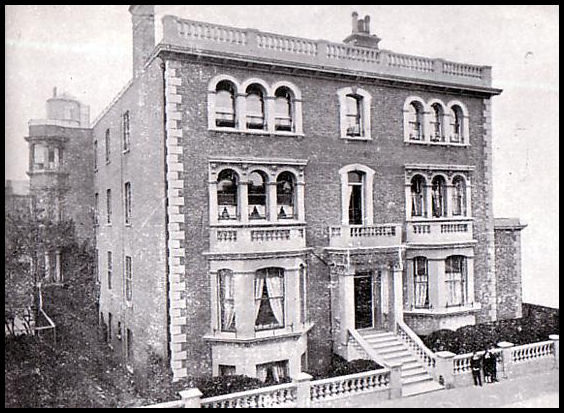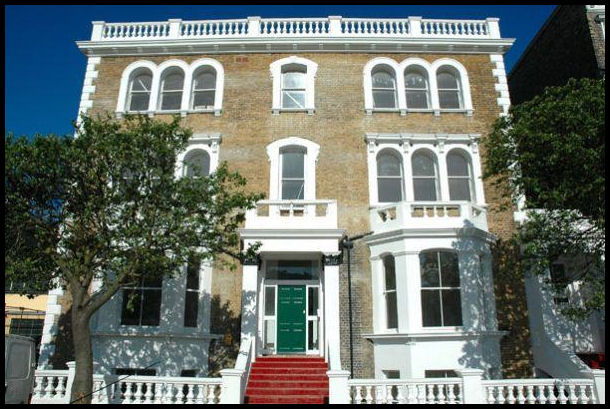


Photograph taken in the early 1900s

Phorograph taken in 2010, by Susannah Foad, of Margate
In the early 19th Century, when, following the Prince Regent, English seaside resorts became hugely popular, the more prosperous middle-classes, living in Margate and the environs, wanted houses of a more grandiose design, providing more luxurious accommodation that reflected their, supposed, personal importance.
The opening of the new railways, from London to the Kent coast, brought visitors and money to seaside resorts such as Margate, and provided the capital to build new homes for the residents and new hotels for the visitors; it was as a result of this that the area, now known as Cliftonville. In 1872, as part of that expansion, ‘Dalby Square′;, in Cliftonville, was built.
One of the new buildings in that square, number 16, became an all-boys school, named "Palmer House". The census of 1881 lists the schoolmaster, Philip Stewart, living at number 16, with his family, servants, other teachers and the pupils. For those interested, this link will take you to a transcription of that census. [Please note this is a 'pdf' file and you will need Adobe Reader installed]
In 1886, a Reverend George Hugh Jones, took over "Palmer House School" and renamed it, "New College" – like "Palmer House", again it was an all-boys school. The Rev George Hugh Jones, who started his academical career at Christ's Hospital and, then, at King's College London, was the son of a, at the time, well-known, J H Jones, who made a reputation for himself, of Trinity College, for his tutorial work, which enabled his pupils to rise to the highest positions in the Church and at the Bar.
The building still stands today, but was converted into flats in the 1980′;s, having, previously, been a hotel after the school closed.[Photos of No. 16 - 16_dalby.jpg],
The following comes from a guide called, "Illustrated and Historical Margate" – "Its attractions as a seaside and holiday resort", published around 1896, and printed by J S Rochard and Co, Gravesend, Fakenham and Norfolk - this was about six years after my grandfather had left but it still must have applied when he was there.
"The school and class rooms, as well as the dormitories, dining hall and other domestic apartments are spacious, well furnished and faultless from a hygienic point of view, and the domestic arrangements, which are under the special personal supervision of Mrs Jones, are of a very superior class".
"Technical education also receives the attention its importance deserves, and in addition to the well appointed physical and Chemical Laboratories, there are well equipped Carpenters and Pattern Maker's shops and a Mechanic's shop etc presided over by experienced, practical craftsmen. The general course includes Latin, Greek, German, French, Mathematics, Natural Science, English Grammar, Composition, Literature etc, Drawing, Vocal Music and many other branches; but of course, the curriculum is adapted to the special powers and requirements of each boy"
The guide goes on to say that the boys were sent up for the Public School various higher examinations, such as the University of London Matriculation, the South Kensington Science and Art, College of Preceptors, Oxford and Cambridge Locals etc.
They were also taught to swim, book keeping, banking operations, invoices, laws and customs of bills of exchange, and, really, every principle of Banking.
For swimming they would use the Clifton Baths which later became the Lido. The original baths were built in 1827 but, in 1837, these had been rebuilt in a pseudo-oriental style. Separate facilities for each sex were, of course, provided, while hot and tepid baths were available.
What a difference my grandfather must have seen when he took on the head-teachership of Hooe National School! But that story comes much later.